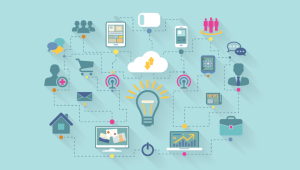
Revitalizing Retail with Big Data Analytics
Retail has been a subject dear to my heart since I started my career. Partly due to my early involvement with this industry as a consultant, I like the challenges and opportunities it brings when it comes to data and analytics.
In 2005, I worked with a large retailer to help them create 360 degree of their product information. It may sound like a small task but was a daunting effort where millions of products and their dynamic attributes needed to be created, categorized, and managed in a centralized repository. This data was then provisioned to numerous downstream channels resulting in consistent product information and for simple analytics work. Back then, not many looked into the aspects such as – what customers are talking about our brand in their social circle, how to target and sell products to customers based on preferences, what my web page searches tell me about the demand etc.
Fast forward today, retail is a different animal and looks lot like a giant, angry elephant ready to charge. As the world is growing more and more connected and, as a result, becoming more complex, retail industry is faced with tremendous volume, variety, velocity and veracity of data. In a world where the customer is in the driver’s seat, now more than ever, retailers are interested in the new insights data can reveal. They are trying to gain these insights from treasure trove of big data sources, which are at their disposal. Knowing that this knowledge is worth a lot of money, they are relying on disruptive technologies such as Hadoop, which promise to be one of only few ways we can tame the big data mammoth.
As an example, today’s retail enterprises have increasingly found success by utilizing big data in their marketing. They are using this data to build customer-specific profiles, help target products to customers, select the most efficient shipping method for products, and showcase applicable products and services by targeting customer interest. This creates huge value for the business as well as customers and today’s smart executives recognize this.
In an article from The Globe and Mail, Josh O’Kane writes that, “Data-driven decision making is no longer just the job of the IT department. Companies now track information more than ever for customer relationship management. Whether it’s simple demographic and sales information or complex ‘Big Data’ such as huge sets of down-to-the-mouse-click digital retail behavior tracking, data has become a crucial tool for entire organizations to react to customer needs.” (Source)
He continues on to note that, “Rather than handing the C-suite monthly spreadsheets on customer data, companies can now let any employee have a dashboard to access analytics to measure corporate health and customer behavior. With that kind of power in everyone’s hands, the work no longer has to fall behind the curtain of the IT departments”.
So how does big data improve the efficiency of marketing departments? The infographic below reveals how big data is giving retailers competitive edge and boosting growth.
(Source)
By effectively collecting and analyzing big data and making data collection and analysis a business priority, retailers are reaching new customers, finessing their services, and increasing their revenue. Big data analysis gives retailers an edge over their opponents and helps them stay competitive in the modern marketplace.
Originally published on MidSize Insider July 2014
COMMENTS
RECENT POSTS

Composable Applications Explained: What They Are and Why They Matter
Composable applications are customized solutions created using modular services as the building blocks. Like how...

Is ChatGPT a Preview to the Future of Astounding AI Innovations?
By now, you’ve probably heard about ChatGPT. If you haven’t kept up all the latest...

How MDM Can Help Find Jobs, Provide Better Care, and Deliver Unique Shopping Experiences
Industrial data is doubling roughly every two years. In 2021, industries created, captured, copied, and...
